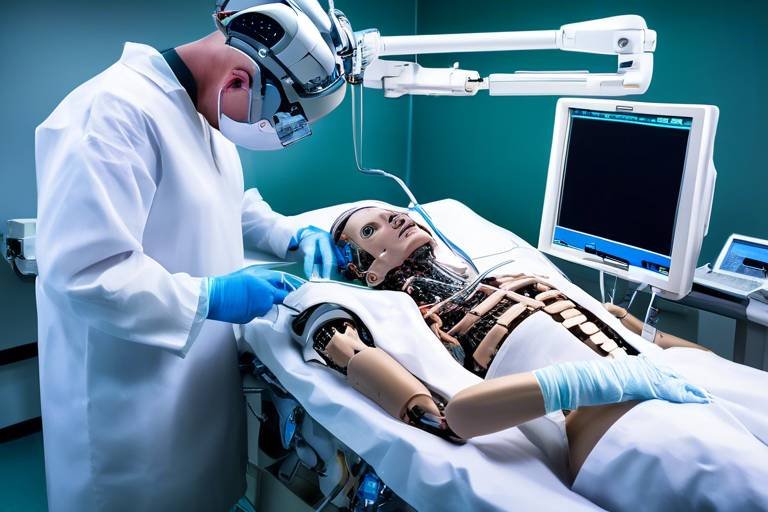The Intersection of Neuroscience and Wearable Technology
In recent years, the fusion of neuroscience and wearable technology has sparked a revolution in how we understand the brain and monitor our health. Imagine a world where your smartwatch not only tracks your steps but also provides insights into your brain activity, helping you manage stress and improve mental health. This is not just a futuristic dream; it's happening right now! As we delve deeper into this fascinating intersection, we’ll explore how advancements in neuroscience are shaping the development of innovative wearable devices. These devices are not only enhancing our understanding of neurological processes but also paving the way for improved health outcomes.
At the core of this transformation is the profound knowledge gained from neuroscience. By studying the intricate workings of the brain, scientists and engineers are designing wearables that can interact with our neurological systems. This synergy between technology and biology is not only exciting but also offers practical applications that can change lives. From monitoring mental health to aiding rehabilitation, the possibilities are endless.
So, what does this mean for you? If you’re someone who values health and wellness, or if you're simply curious about how technology can enhance your life, understanding this intersection is crucial. Imagine having the ability to receive real-time feedback about your mental state or learning how your brain responds to various stimuli throughout your day. This is the promise of wearable technology powered by neuroscience!
In the following sections, we will dive deeper into the basics of neuroscience, the evolution of wearable technology, and the exciting devices that are currently on the market. We’ll also discuss how these technologies are impacting mental health and what the future holds. Buckle up, because this journey into the brain and beyond is just getting started!

Understanding Neuroscience Basics
Neuroscience is a fascinating field that dives deep into the complexities of the brain and nervous system. To truly grasp how wearable technology can enhance our understanding of neurological processes, it's essential to get a grasp on some foundational concepts. The brain, often likened to a highly sophisticated computer, is composed of billions of neurons that communicate through intricate networks. This communication is what allows us to think, feel, and react to the world around us.
At its core, neuroscience examines various aspects of the brain, including its structure, functions, and the biochemical processes that govern our thoughts and behaviors. Understanding these elements is crucial for developing effective wearable technology that can monitor and interact with neurological activities. For instance, the brain is divided into several regions, each responsible for different functions:
- Cerebrum: The largest part of the brain, responsible for higher brain functions like thought and action.
- Cerebellum: Involved in coordination and balance.
- Brainstem: Controls basic life functions such as breathing and heart rate.
Each of these regions works in concert to create the rich tapestry of human experience. When we consider the development of wearable devices, it becomes clear that a deep understanding of these brain functions is essential. For example, a device that tracks brainwave activity can provide insights into a user's mental state, potentially leading to breakthroughs in mental health management.
Moreover, the interplay between neuroscience and technology opens up exciting possibilities. With advancements in neuroimaging and data analytics, researchers can now collect and analyze vast amounts of data from wearable devices. This data can reveal patterns in brain activity, helping us understand how various factors, such as stress or sleep, impact our cognitive functions and overall well-being.
In summary, the basics of neuroscience lay the groundwork for innovative wearable technology. By understanding the brain's structure and functions, developers can create devices that not only monitor health metrics but also provide valuable insights into our neurological health. As we continue to explore this intersection, the potential for enhancing our understanding of the brain and improving health outcomes becomes increasingly apparent.

The Rise of Wearable Technology
Wearable technology has come a long way since the days of simple pedometers. Today, it represents a dynamic intersection of innovation and personal health, transforming how we monitor our well-being. The rise of wearables can be attributed to several factors, including advancements in technology, increased health consciousness among consumers, and a growing demand for real-time data. Imagine walking down the street, and your wrist vibrates to remind you to take a deep breath—this is not just a fantasy anymore but a reality thanks to smart devices that are becoming increasingly sophisticated.
In recent years, we've witnessed a surge in the development of various wearable devices, from smartwatches to fitness trackers, all designed to enhance our understanding of health and fitness. The appeal of these gadgets lies in their ability to seamlessly integrate into our daily lives, offering insights that were once only available through clinical settings. For instance, heart rate monitors can now be worn on your wrist, providing continuous data that can alert you to potential health issues before they escalate.
Moreover, the evolution of wearable technology is also driven by the growing trend of personalization. Consumers are no longer satisfied with one-size-fits-all solutions; they seek devices that cater to their unique health needs and preferences. This has led to the development of specialized wearables that focus on specific health metrics, such as sleep quality, hydration levels, and even stress management. These innovations not only empower individuals to take control of their health but also encourage a proactive approach to wellness.
As we look at the current landscape, several key players dominate the market, each contributing to the rise of wearables in unique ways. Companies like Apple and Fitbit have made significant strides in integrating advanced sensors and algorithms into their devices, allowing users to track a wide range of health metrics. Below is a table highlighting some of these popular wearable devices and their core functionalities:
| Device | Core Functionality | Unique Feature |
|---|---|---|
| Apple Watch | Heart rate monitoring, ECG, activity tracking | Fall detection and emergency SOS |
| Fitbit Charge | Step tracking, sleep analysis, heart rate monitoring | Daily readiness score |
| Oura Ring | Sleep tracking, readiness, activity tracking | Temperature sensors for health insights |
| Whoop Strap | Heart rate variability, strain, recovery | Subscription model for personalized coaching |
As the technology continues to advance, the future of wearables looks promising. We are on the brink of even more exciting innovations that could change the way we interact with our health. The integration of artificial intelligence and machine learning into wearable devices could lead to more accurate health predictions and personalized recommendations. For instance, imagine a wearable that not only tracks your physical activity but also analyzes your emotional state and suggests mindfulness exercises tailored to your mood.
In conclusion, the rise of wearable technology is not just a trend; it's a revolution in how we approach health and wellness. With each passing day, these devices become more intelligent and capable, offering us unprecedented insights into our bodies and minds. As we embrace this technology, it opens up new avenues for understanding our health and enhancing our lives.

Key Wearable Devices
In recent years, the market for wearable technology has exploded, with numerous devices designed to monitor health and enhance our understanding of personal well-being. These gadgets are not just trendy accessories; they are powerful tools that can provide significant insights into our physical and neurological health. Among the most popular devices are smartwatches, fitness trackers, and brain-computer interfaces (BCIs). Each of these devices brings unique capabilities to the table, allowing users to track various health metrics and, in some cases, even interact with their neurological processes.
Smartwatches have become ubiquitous, serving as both a fashion statement and a health monitoring device. They are equipped with sensors that can track heart rate, monitor sleep patterns, and even alert users to irregularities in their health. For example, many smartwatches can detect when a user's heart rate exceeds a certain threshold, prompting them to take action or seek medical advice. This proactive approach to health monitoring is invaluable, especially for those with existing health conditions.
On the other hand, fitness trackers have carved out their niche by focusing on physical activity and fitness goals. These devices often come with features that allow users to set goals, track their progress, and receive feedback on their performance. For instance, many fitness trackers can monitor steps taken, calories burned, and even provide insights into the quality of a workout. By collecting this data, users can gain a better understanding of their physical health and make informed decisions about their fitness routines.
Perhaps the most exciting developments in wearable technology are in the realm of brain-computer interfaces (BCIs). These cutting-edge devices are designed to establish a direct communication pathway between the brain and external devices. BCIs have significant implications for both medical rehabilitation and cognitive enhancement. For example, individuals with mobility impairments can use BCIs to control prosthetic limbs or even navigate computer interfaces using their thoughts. This technology is not just revolutionary; it's a glimpse into a future where our thoughts can directly influence the digital world around us.
To illustrate the diversity of wearable devices currently available, here's a brief overview of some key features:
| Device Type | Key Features | Potential Applications |
|---|---|---|
| Smartwatches | Heart rate monitoring, sleep analysis, notifications | Health tracking, fitness coaching, emergency alerts |
| Fitness Trackers | Step counting, calorie tracking, workout analysis | Fitness goal tracking, weight management, performance improvement |
| Brain-Computer Interfaces | Thought-based control, brain activity monitoring | Medical rehabilitation, cognitive enhancement, gaming |
As wearable technology continues to evolve, we can expect even more innovative devices to emerge, each designed to enhance our understanding of health and well-being. The intersection of neuroscience and wearable technology is not just a trend; it represents a fundamental shift in how we approach health monitoring and personal performance enhancement. With each new device, we are gaining deeper insights into our bodies and minds, paving the way for a healthier future.

Smartwatches and Health Monitoring
Smartwatches have rapidly evolved from simple timepieces into sophisticated health monitoring devices that can significantly impact our daily lives. These gadgets are not just about telling time; they are equipped with an array of sensors that track various health metrics. Imagine having a personal health assistant right on your wrist, constantly gathering data about your body and helping you make informed health decisions. This transformation is nothing short of revolutionary, as it empowers users to take control of their health in real-time.
One of the most notable features of smartwatches is their ability to monitor heart rate. With the help of photoplethysmography (PPG) technology, these devices can detect changes in blood volume, providing users with accurate heart rate readings throughout the day. This data is invaluable for those looking to maintain a healthy lifestyle or monitor their fitness levels. But that’s not all; smartwatches also offer sleep analysis, which can help users understand their sleep patterns and improve their overall rest quality. By analyzing sleep stages, such as light, deep, and REM sleep, these devices can provide personalized insights that lead to better sleep hygiene.
Furthermore, smartwatches can collect neurological data, which is a game-changer in health monitoring. They can measure stress levels through heart rate variability (HRV) and provide users with actionable feedback. For instance, if your smartwatch detects an increase in your heart rate due to stress, it might suggest breathing exercises or mindfulness activities to help you calm down. This level of interaction not only enhances user engagement but also promotes a proactive approach to health management.
To illustrate the capabilities of smartwatches, here’s a table summarizing some of the key health metrics they can track:
| Health Metric | Description |
|---|---|
| Heart Rate | Continuous monitoring of heart rate throughout the day, providing insights into overall cardiovascular health. |
| Sleep Quality | Analysis of sleep patterns, including duration and stages of sleep, to improve sleep hygiene. |
| Activity Tracking | Counts steps, tracks workouts, and monitors calorie expenditure for fitness enthusiasts. |
| Stress Levels | Measures heart rate variability to assess stress and provide feedback on relaxation techniques. |
In addition to these features, smartwatches are increasingly integrating with other health apps and devices, creating a comprehensive health ecosystem. Users can sync their smartwatch data with fitness apps, nutrition trackers, and even telehealth services, making it easier than ever to maintain a holistic view of their health. As technology continues to advance, we can expect even more innovative features that will further enhance our understanding of our bodies and minds.
In conclusion, smartwatches are not just trendy accessories; they are powerful tools for health monitoring that can lead to better health outcomes. By providing real-time data and personalized insights, these devices empower individuals to make informed decisions about their health, ultimately promoting a healthier lifestyle. As we embrace this technology, the possibilities for improving our well-being are truly exciting.
- What health metrics can smartwatches track? Smartwatches can track heart rate, sleep quality, activity levels, and stress levels, among other metrics.
- How accurate are smartwatches in monitoring health? While smartwatches provide valuable insights, their accuracy can vary based on the technology used and individual factors.
- Can smartwatches help with mental health management? Yes, many smartwatches offer features that can help track mood and stress levels, providing feedback for better emotional well-being.

Brain-Computer Interfaces (BCIs)
Brain-Computer Interfaces, commonly known as BCIs, represent a groundbreaking fusion of neuroscience and technology. These devices pave the way for a future where direct communication between the brain and external devices is not just a possibility but a reality. Imagine being able to control a computer or a robotic arm simply by thinking about it! This is the promise that BCIs hold, and it’s not just science fiction anymore; it’s happening right now.
At their core, BCIs work by detecting brain signals and translating them into commands that can be understood by computers or other devices. This process typically involves the use of electrodes placed on the scalp or implanted within the brain. The data collected from these electrodes is then analyzed using sophisticated algorithms to interpret the user’s intentions. For instance, if someone thinks about moving their hand, the BCI can pick up on the corresponding brain activity and relay that information to a prosthetic limb, allowing it to move in sync with the user’s thoughts.
The applications of BCIs are vast and varied. In the medical field, they are proving to be invaluable for rehabilitation. For patients recovering from strokes or spinal cord injuries, BCIs can facilitate therapy by enabling them to control assistive devices with their thoughts, thus promoting neural recovery and motor function. Additionally, BCIs are being explored for their potential to enhance cognitive functions, such as memory and attention, offering hope for individuals with neurodegenerative diseases.
Moreover, the implications of BCIs extend beyond medical applications. In the realm of gaming and virtual reality, BCIs have the potential to revolutionize user experiences by allowing players to interact with their environments using only their minds. Imagine a video game where your character moves and reacts purely based on your thoughts—an exhilarating prospect that could change the landscape of entertainment.
Despite the exciting advancements, it’s important to address the challenges that come with BCIs. Issues such as data privacy, ethical considerations, and the need for extensive training to use these devices effectively are crucial topics that researchers and developers must navigate. As we continue to explore the capabilities of BCIs, a careful balance between innovation and responsibility will be essential.
In summary, Brain-Computer Interfaces are not just a technological marvel; they are a beacon of hope for many. Their ability to bridge the gap between human thought and machine response opens new avenues for medical rehabilitation, cognitive enhancement, and interactive experiences. As we stand on the brink of this new frontier, it’s clear that the future of BCIs is bright and full of potential.
- What are Brain-Computer Interfaces (BCIs)?
BCIs are devices that enable direct communication between the brain and external devices, allowing users to control technology using their thoughts. - How do BCIs work?
BCIs detect brain signals through electrodes and translate these signals into commands that can be executed by computers or other devices. - What are the applications of BCIs?
BCIs have applications in medical rehabilitation, cognitive enhancement, gaming, and even communication for individuals with disabilities. - Are there any risks associated with BCIs?
Yes, there are risks related to data privacy, ethical considerations, and the potential for misuse of the technology.

Neuroscience Insights from Wearables
As we dive deeper into the fascinating world of neuroscience, it's becoming increasingly clear that wearable technology is not just a trend; it's a revolution in how we understand our brains and mental health. These devices are like tiny scientists strapped to our wrists, gathering a wealth of data that can illuminate the intricate workings of our minds. With every heartbeat, every step, and every sleep cycle, wearables are transforming raw data into valuable insights about our neurological health.
Imagine having a personal assistant that tracks your brain activity in real-time, providing feedback on your mental state and cognitive performance. This is precisely what wearables are doing. By measuring physiological markers such as heart rate variability, sleep patterns, and even skin temperature, these devices paint a detailed picture of our mental health. For instance, research has shown that fluctuations in heart rate can indicate stress or anxiety levels, allowing users to take proactive steps toward managing their emotional well-being.
Moreover, the integration of advanced sensors in wearables has opened the door to a new frontier in neuroscience research. These devices can collect continuous data, enabling scientists to analyze trends over time. For example, studies have demonstrated that tracking sleep quality through wearables can lead to better understanding of conditions like insomnia or depression. The ability to correlate sleep disturbances with daily activities or stressors can provide a clearer picture of how our lifestyle choices affect our mental health.
Here’s a closer look at some of the insights being gathered from wearables:
- Real-time Monitoring: Wearables provide immediate feedback on physiological changes, allowing users to adjust their behaviors accordingly.
- Data-Driven Decisions: With access to personalized data, users can make informed choices about their health and well-being.
- Research Advancements: Continuous data collection aids researchers in identifying patterns and correlations that were previously difficult to discern.
In addition to individual insights, the aggregated data from wearables can lead to breakthroughs in public health research. By analyzing data from thousands of users, researchers can identify trends in mental health issues across different demographics, potentially leading to more effective interventions and support systems. This collective intelligence could be a game-changer in how we approach mental health on a societal level.
As we continue to explore the potential of wearable technology, one thing is certain: the insights gained from these devices are paving the way for a new understanding of the brain. They are not just gadgets; they are gateways to a deeper connection with our mental health, empowering us to take charge of our emotional well-being like never before.
- How do wearables measure brain activity?
Wearables typically use sensors to track physiological indicators such as heart rate, sleep patterns, and activity levels, which can be correlated with brain activity. - Can wearables help with mental health issues?
Yes, wearables can provide insights into stress, anxiety, and other mental health conditions by monitoring physiological responses and offering real-time feedback. - What types of wearables are best for tracking neurological health?
Devices like smartwatches and specialized brain-computer interfaces are particularly effective for monitoring neurological health.

Impact on Mental Health
The intersection of wearable technology and neuroscience is not just a fascinating subject; it’s a game-changer for mental health management. Imagine having a personal assistant that never sleeps, always monitoring your mood and stress levels. This is what modern wearables can do! By utilizing advanced sensors and algorithms, these devices can track physiological signals that correlate with your mental state. For instance, changes in heart rate variability, skin temperature, and even sleep patterns can provide insights into your emotional well-being.
One of the most exciting aspects of wearable technology is its ability to offer real-time feedback. Picture this: you're having a particularly stressful day at work, and your smartwatch vibrates, alerting you to elevated stress levels. It could suggest a quick breathing exercise or a moment of mindfulness to help you recalibrate. This kind of immediate intervention can be crucial. It’s like having a coach in your pocket, reminding you to take a step back and breathe when the world feels overwhelming.
Moreover, the data collected by these devices can be invaluable for both users and mental health professionals. By analyzing trends over time, individuals can identify triggers and patterns in their mood and stress levels. This data can be shared with therapists or counselors, providing a clearer picture of a person’s mental health journey. For example, if someone notices that their anxiety spikes on certain days or after specific activities, they can work with a professional to develop coping strategies tailored to their unique experiences.
To illustrate the impact of wearables on mental health management, consider the following table:
| Wearable Device | Functionality | Benefits |
|---|---|---|
| Smartwatches | Heart rate monitoring, sleep tracking | Identifying stress patterns, improving sleep quality |
| Fitness Trackers | Activity tracking, mood logging | Encouraging physical activity, raising awareness of mood changes |
| BCIs (Brain-Computer Interfaces) | Direct brain activity monitoring | Real-time feedback for anxiety management, cognitive enhancement |
As we delve deeper into the capabilities of these devices, it’s clear that they can help individuals develop a more profound understanding of their mental health. For instance, many wearables now come equipped with features that promote mindfulness and relaxation. Users can receive reminders to practice deep breathing or engage in short meditation sessions throughout the day. These small nudges can accumulate into significant improvements in emotional well-being.
However, it’s essential to approach this technology with a balanced mindset. While wearables can provide valuable insights, they should not replace professional mental health care. Instead, think of them as complementary tools that empower individuals to take charge of their mental health. Just like how a fitness tracker can motivate you to be more active, a mental health wearable can encourage you to check in with your emotions regularly.
In conclusion, the impact of wearable technology on mental health is profound and multifaceted. As these devices continue to evolve, we can expect even more innovative features that promote mental well-being. The future is bright for those who seek to harness the power of technology to enhance their emotional health. So, are you ready to embrace this new era of mental health management?
- How do wearables track mental health? Wearables monitor physiological signals such as heart rate, sleep patterns, and activity levels, which can indicate stress and mood changes.
- Can wearables replace therapy? No, while wearables can provide valuable insights, they should complement professional mental health care rather than replace it.
- What are some popular mental health wearables? Some popular devices include smartwatches with health tracking features, fitness trackers, and brain-computer interfaces (BCIs).

Wearables for Stress Management
In today's fast-paced world, managing stress has become more crucial than ever. Fortunately, wearable technology is stepping up to the plate, providing users with tools to better understand and manage their stress levels. Imagine having a personal assistant that not only tracks your heart rate but also gives you real-time insights into your emotional state. Sounds like science fiction, right? Well, it’s a reality today!
Wearable devices equipped with sensors can monitor physiological indicators such as heart rate variability, skin temperature, and even sweat levels. These metrics are like the breadcrumbs that lead us to understanding our body's response to stress. For instance, when you’re under pressure, your heart rate might spike, and your skin temperature may drop. By keeping tabs on these indicators, wearables can alert you when your body is signaling distress, allowing you to take proactive measures.
Many wearables now come with built-in features designed specifically for stress management. These features often include:
- Biofeedback: This technique provides real-time data about your physiological functions, helping you recognize when you're stressed and allowing you to take action to calm down.
- Mindfulness Reminders: Some devices send notifications to remind you to take a breather, practice deep breathing, or engage in a quick meditation session.
- Personalized Health Insights: Based on the data collected, wearables can provide tailored advice, helping you understand what triggers your stress and how to manage it effectively.
Imagine you're at work, and the deadline is looming. Your smartwatch vibrates, alerting you that your heart rate has exceeded your normal range. This instant feedback could prompt you to take a few minutes to practice mindfulness or deep breathing exercises, effectively lowering your stress levels before they escalate. It's like having a coach on your wrist, guiding you toward better emotional health.
Moreover, the integration of apps with wearable devices enhances the user experience. Many wearables sync with mobile applications that allow users to log their mood, track their stress triggers, and review their progress over time. This data not only empowers users but also provides valuable insights for researchers studying the effects of stress on mental health.
As we look to the future, the potential for wearables in stress management is enormous. With advancements in artificial intelligence and machine learning, we can expect even more sophisticated algorithms that can predict stress levels before they peak. Imagine a device that can sense an impending stress episode and automatically suggest calming techniques tailored to your preferences. The possibilities are endless!
In conclusion, wearables are revolutionizing how we manage stress, providing us with the tools to understand our bodies better and respond proactively. As this technology continues to evolve, we can anticipate even more personalized and effective solutions for stress management, making our lives not just more manageable, but also more enjoyable.
Q1: How do wearables measure stress?
A1: Wearables measure stress through various physiological indicators such as heart rate variability, skin conductance, and even sleep patterns, providing valuable insights into your emotional state.
Q2: Can wearables really help reduce stress?
A2: Yes! By providing real-time feedback and personalized insights, wearables can help users identify stress triggers and implement strategies to manage them effectively.
Q3: Are there specific wearables designed for stress management?
A3: Many smartwatches and fitness trackers now include features specifically designed for stress management, such as biofeedback, mindfulness reminders, and stress tracking capabilities.

Future Trends in Neuroscience and Wearables
The future of neuroscience and wearable technology is nothing short of exhilarating. With each passing year, we witness groundbreaking innovations that push the boundaries of what we thought was possible. Imagine a world where your wearable device not only tracks your physical activity but also provides real-time insights into your neurological health. This is not just a dream; it's on the horizon! As researchers continue to delve into the complexities of the brain, we can expect a surge of advancements that will redefine how we interact with technology.
One of the most exciting trends is the integration of artificial intelligence (AI) with wearable devices. AI can analyze vast amounts of data collected from wearables to identify patterns and predict potential health issues before they arise. For example, a smartwatch equipped with AI could monitor your heart rate variability and alert you about stress levels, suggesting mindfulness exercises tailored to your needs. This level of personalization could revolutionize preventive healthcare, making it more proactive rather than reactive.
Moreover, the development of neurofeedback technology is gaining traction. This technology allows users to receive real-time feedback on their brain activity, enabling them to train their minds for better focus, relaxation, or even enhanced creativity. Picture a wearable headband that can help you meditate more effectively by guiding you through your mental state. Such advancements could empower individuals to take control of their mental well-being, making neuroscience accessible to everyone.
Another trend to watch is the rise of biometric sensors that monitor brain health. These sensors can track various neurological parameters, such as brainwave patterns and neurotransmitter levels. By integrating these sensors into everyday wearables, we could gain unprecedented insights into our cognitive health. Imagine wearing a pair of glasses that not only corrects your vision but also provides feedback on your cognitive performance throughout the day. The implications for education, productivity, and mental health are staggering.
Furthermore, as technology advances, we can expect to see more collaborative platforms that connect wearables with healthcare professionals. These platforms will allow for seamless data sharing, enabling doctors to monitor their patients' neurological health remotely. This could lead to more timely interventions and personalized treatment plans, ultimately improving health outcomes. The synergy between neuroscience and wearable technology is paving the way for a future where healthcare is more integrated and patient-centered.
In conclusion, the intersection of neuroscience and wearable technology is set to transform our understanding of the brain and our approach to health. With innovations like AI integration, neurofeedback technology, biometric sensors, and collaborative platforms, the future looks bright. As we continue to explore these possibilities, we can only imagine the profound impact they will have on our lives. The journey has just begun, and the best is yet to come!
- What are wearable devices? Wearable devices are electronic gadgets that can be worn on the body, often used to track health metrics, fitness activities, and even neurological data.
- How can wearables improve mental health? Wearables can monitor stress levels, track mood, and provide real-time feedback, helping users manage their mental health more effectively.
- What is neurofeedback? Neurofeedback is a technique that uses real-time displays of brain activity to teach self-regulation of brain function.
- What future trends should we expect in wearable technology? Expect advancements in AI integration, biometric sensors, and platforms that connect wearables with healthcare professionals for better health management.
Frequently Asked Questions
- What is the role of neuroscience in wearable technology?
Neuroscience plays a crucial role in the development of wearable technology by providing insights into how the brain functions. Understanding brain structure and processes allows developers to create devices that can monitor neurological activity, track cognitive performance, and even interact with the brain in innovative ways.
- How have wearable devices evolved over time?
Wearable devices have come a long way from simple pedometers to sophisticated smartwatches and brain-computer interfaces. The evolution has been driven by advancements in technology, materials, and our understanding of health and fitness, making these devices more capable of monitoring various aspects of our health and enhancing personal performance.
- What types of wearable devices are currently popular?
Some of the most popular wearable devices include smartwatches, fitness trackers, and specialized brain-computer interfaces (BCIs). Each of these devices offers unique features, such as heart rate monitoring, sleep analysis, and even direct communication with the brain, which are revolutionizing our approach to health and wellness.
- How do smartwatches contribute to health monitoring?
Smartwatches contribute to health monitoring by providing real-time data on heart rate, sleep patterns, and even stress levels. They can collect and analyze neurological data, offering users valuable insights into their overall health and enabling proactive management of their well-being.
- What are brain-computer interfaces (BCIs) and their applications?
Brain-computer interfaces (BCIs) are devices that facilitate direct communication between the brain and external devices. They are used in various applications, including medical rehabilitation for patients with neurological impairments and enhancing cognitive functions in healthy individuals.
- How do wearables provide insights into neurological health?
Wearable technology collects data on brain activity and physiological responses, which researchers can analyze to gain insights into neurological health. This data helps in understanding mental health, cognitive performance, and even the effects of stress and anxiety on the brain.
- Can wearable technology help manage mental health?
Yes, wearable technology can significantly aid in mental health management by tracking mood, stress levels, and providing real-time feedback. These devices can remind users to practice mindfulness or alert them to changes in their emotional state, promoting better emotional well-being.
- What features do wearables offer for stress management?
Wearable devices offer features like biofeedback, mindfulness reminders, and personalized health insights. By analyzing real-time data, these devices can help users manage stress more effectively, encouraging healthier coping mechanisms and lifestyle choices.
- What future trends can we expect in neuroscience and wearables?
Future trends in the intersection of neuroscience and wearable technology may include more advanced brain-computer interfaces, enhanced data analytics for better health insights, and the integration of AI to personalize user experiences. These innovations could lead to breakthroughs in our understanding of the brain and improved health outcomes.



















